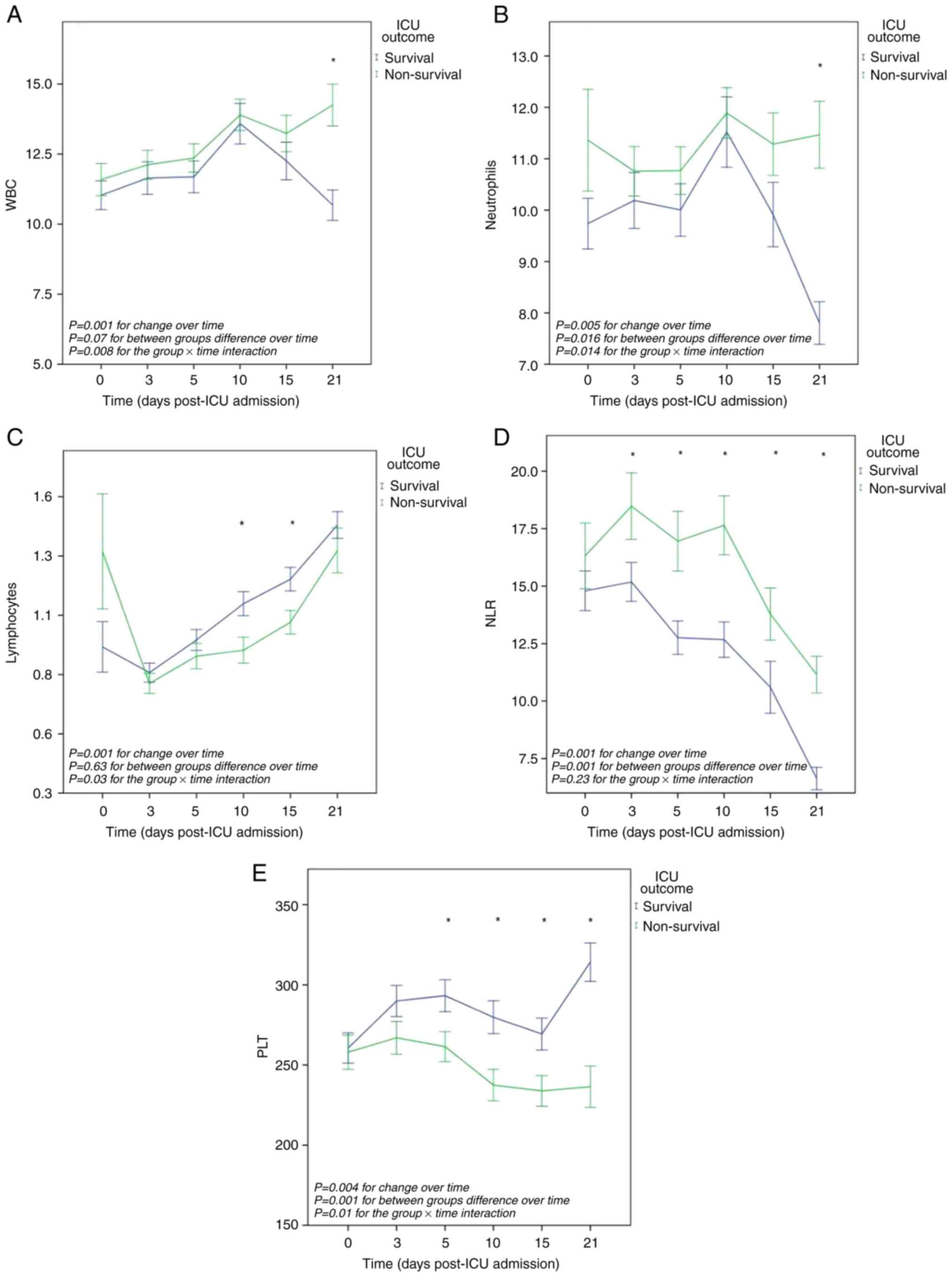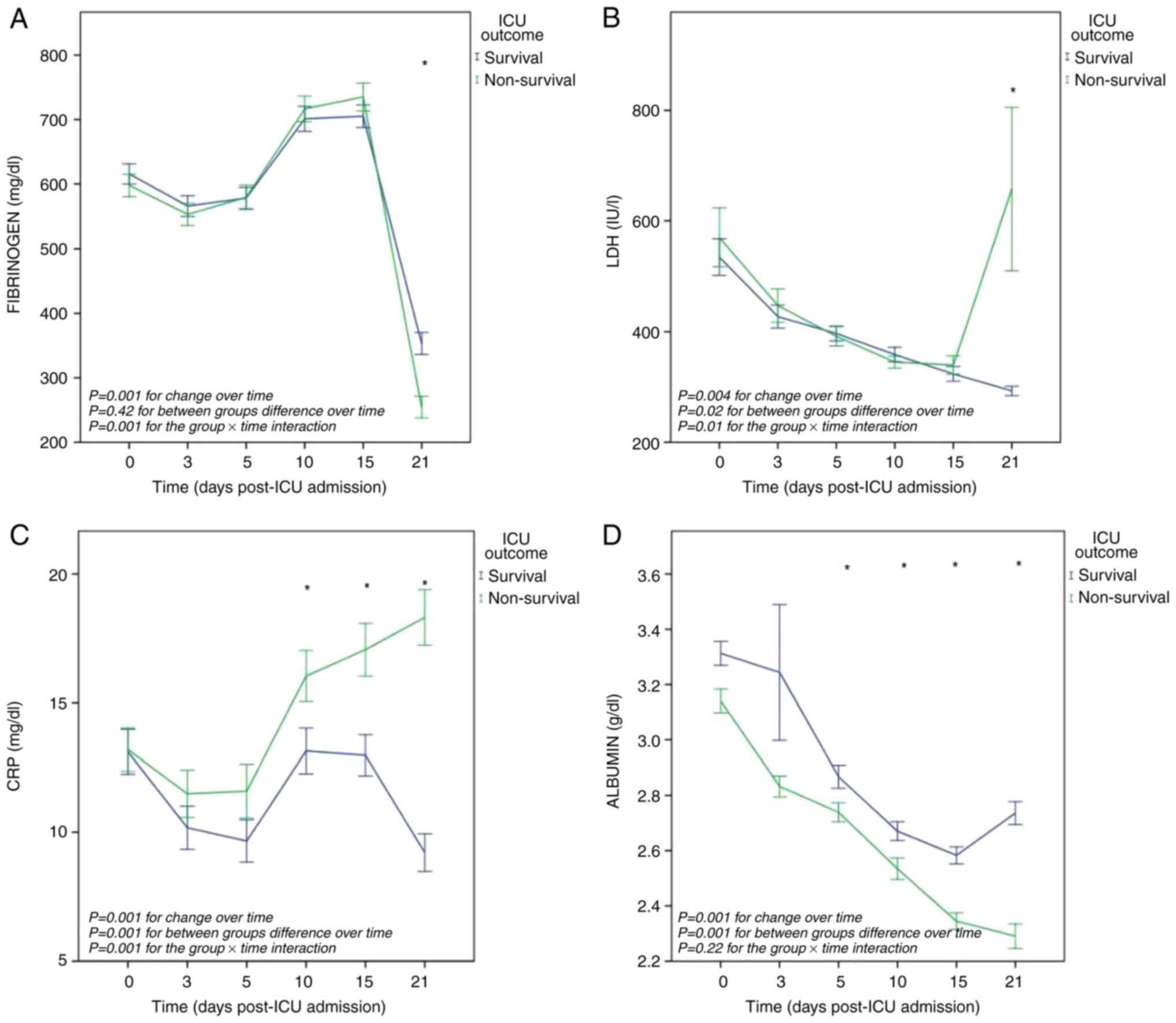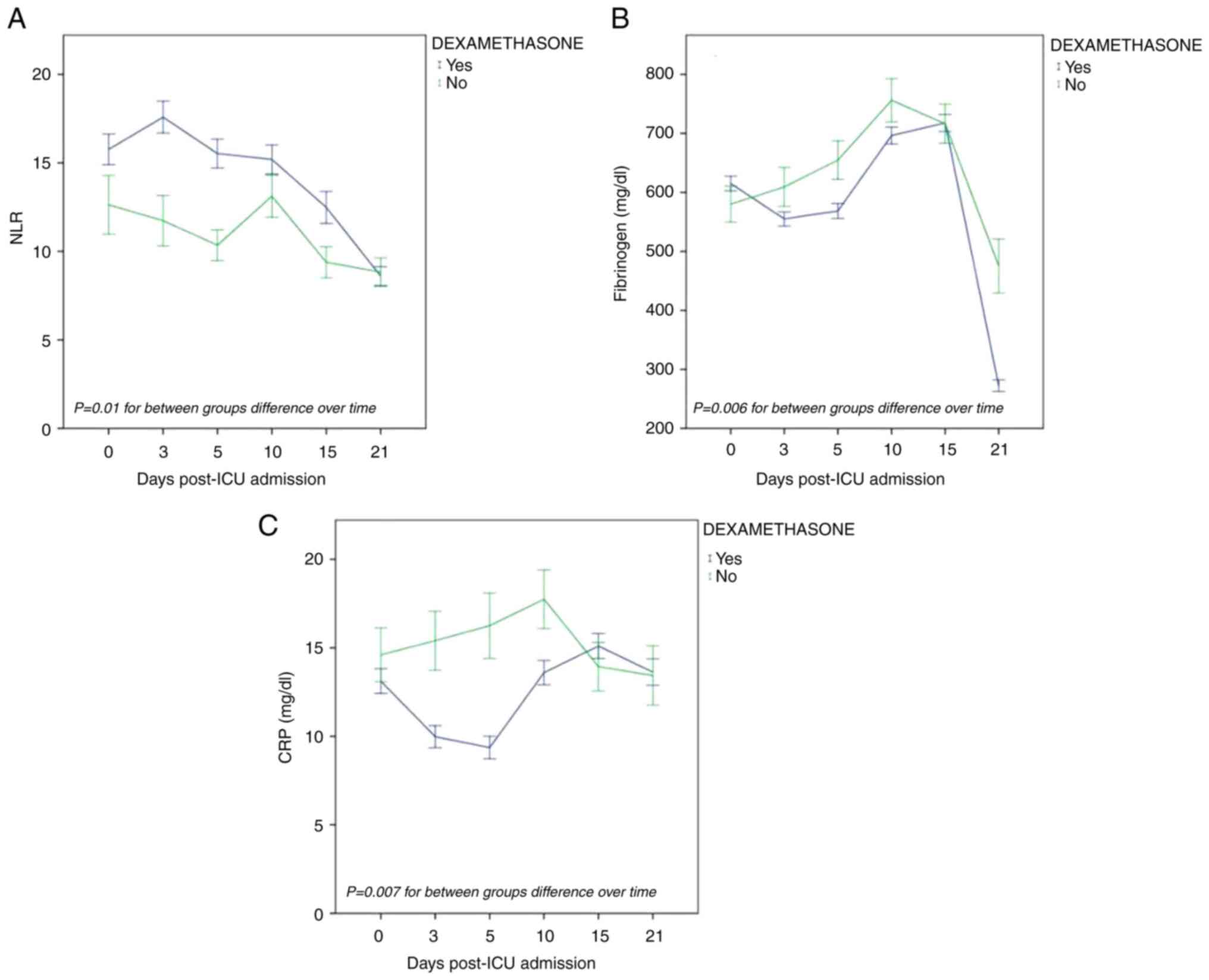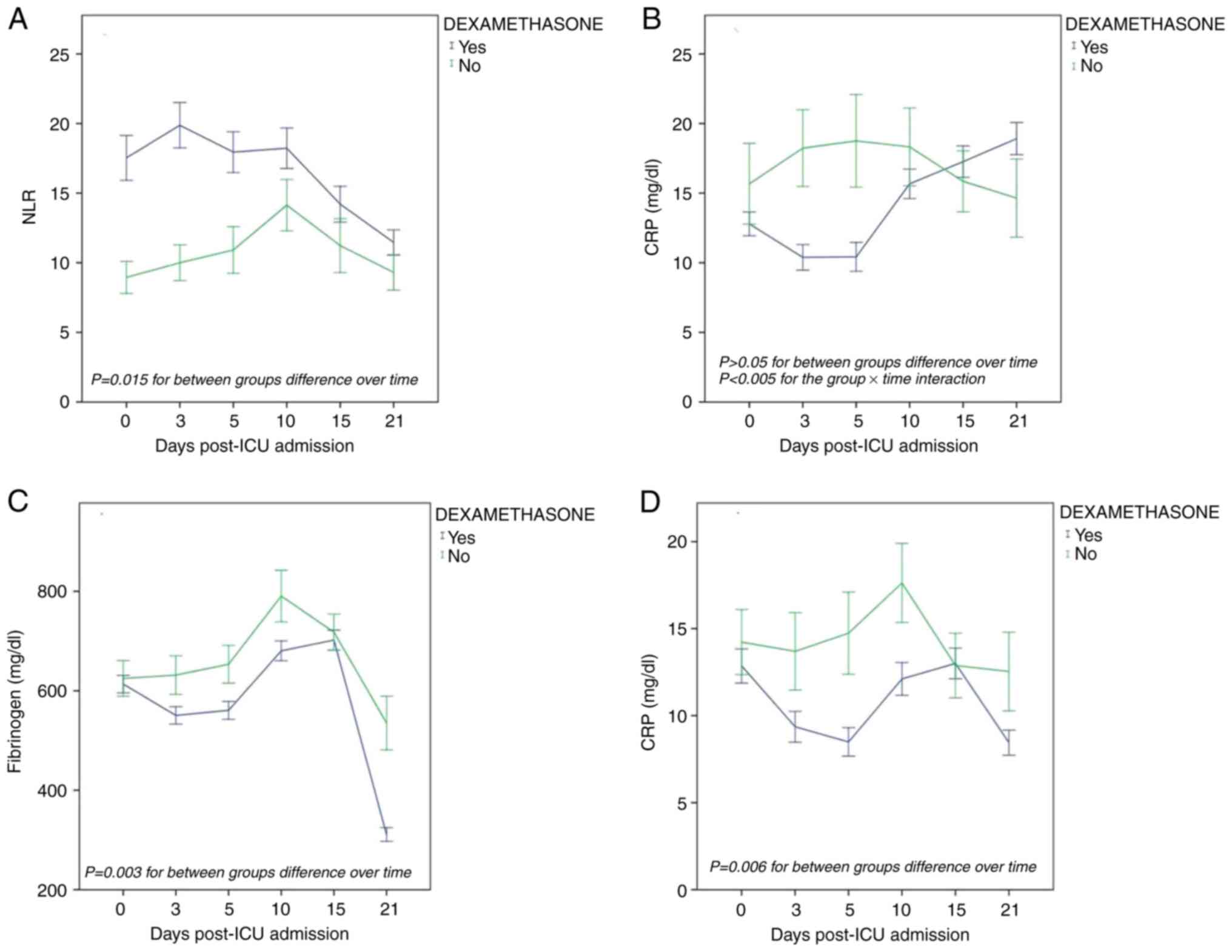|
1
|
World Health Organization (WHO):
Coronavirus disease (COVID2019) situation reports. https://www.who.int/emergencies/diseases/novel-coronavirus-2019/situation-reports.
Accessed October 22, 2020.
|
|
2
|
Zhou F, Yu T, Du R, Fan G, Liu Y, Liu Z,
Xiang J, Wang Y, Song B, Gu X, et al: Clinical course and risk
factors for mortality of adult inpatients with COVID-19 in Wuhan,
China: A retrospective cohort study. Lancet. 395:1054–1062.
2020.PubMed/NCBI View Article : Google Scholar
|
|
3
|
Grasselli G, Greco M, Zanella A, Albano G,
Antonelli M, Bellani G, Bonanomi E, Cabrini L, Carlesso E, Castelli
G, et al: Risk factors associated with mortality among patients
with COVID-19 in intensive care units in Lombardy, Italy. JAMA
Intern Med. 180:1345–1355. 2020.PubMed/NCBI View Article : Google Scholar
|
|
4
|
Li C, He Q, Qian H and Liu J: Overview of
the pathogenesis of COVID-19 (Review). Exp Ther Med.
22(1011)2021.PubMed/NCBI View Article : Google Scholar
|
|
5
|
Feng Z, Chen Y, Wu Y, Wang J, Zhang H and
Zhang W: Kidney involvement in coronavirus-associated diseases
(Review). Exp Ther Med. 21(361)2021.PubMed/NCBI View Article : Google Scholar
|
|
6
|
Fukui S, Ikeda K, Kobayashi M, Nishida K,
Yamada K, Horie S, Shimada Y, Miki H, Goto H, Hayashi K, et al:
Predictive prognostic biomarkers in patients with COVID-19
infection. Mol Med Rep. 27(15)2023.PubMed/NCBI View Article : Google Scholar
|
|
7
|
Daher J: Endothelial dysfunction and
COVID-19 (Review). Biomed Rep. 15(102)2021.PubMed/NCBI View Article : Google Scholar
|
|
8
|
Lippi G and Plebani M: Laboratory
abnormalities in patients with COVID-2019 infection. Clin Chem Lab
Med. 58:1131–1134. 2020.PubMed/NCBI View Article : Google Scholar
|
|
9
|
Ye J, Jiao Y, Zhang Y, Li Z, Zeng X, Deng
H and Yang M: Hematological changes in patients with COVID-19
(Review). Mol Med Rep. 22:4485–4491. 2020.PubMed/NCBI View Article : Google Scholar
|
|
10
|
Henry BM, de Oliveira MHS, Benoit S,
Plebani M and Lippi G: Hematologic, biochemical and immune
biomarker abnormalities associated with severe illness and
mortality in coronavirus disease 2019 (COVID-19): A meta-analysis.
Clin Chem Lab Med. 58:1021–1028. 2020.PubMed/NCBI View Article : Google Scholar
|
|
11
|
Skevaki C, Fragkou PC, Cheng C, Xie M and
Renz H: Laboratory characteristics of patients infected with the
novel SARS-CoV-2 virus. J Infect. 81:205–212. 2020.PubMed/NCBI View Article : Google Scholar
|
|
12
|
Huang Y, Zhang Y and Ma L: Meta-analysis
of laboratory results in patients with severe coronavirus disease
2019. Exp Ther Med. 21(449)2021.PubMed/NCBI View Article : Google Scholar
|
|
13
|
Bohn MK, Lippi G, Horvath A, Sethi S, Koch
D, Ferrari M, Wang CB, Mancini N, Steele S and Adeli K: Molecular,
serological, and biochemical diagnosis and monitoring of COVID-19:
IFCC taskforce evaluation of the latest evidence. Clin Chem Lab
Med. 58:1037–1052. 2020.PubMed/NCBI View Article : Google Scholar
|
|
14
|
Georgakopoulou VE, Garmpis N, Damaskos C,
Valsami S, Dimitroulis D, Diamantis E, Farmaki P, Papageorgiou CV,
Makrodimitri S, Gravvanis N, et al: The impact of peripheral
eosinophil counts and eosinophil to lymphocyte ratio (ELR) in the
clinical course of COVID-19 patients: A retrospective study. In
Vivo. 35:641–648. 2021.PubMed/NCBI View Article : Google Scholar
|
|
15
|
Georgakopoulou VE, Makrodimitri S,
Triantafyllou M, Samara S, Voutsinas PM, Anastasopoulou A,
Papageorgiou CV, Spandidos DA, Gkoufa A, Papalexis P, et al:
Immature granulocytes: Innovative biomarker for SARS-CoV-2
infection. Mol Med Rep. 26(217)2022.PubMed/NCBI View Article : Google Scholar
|
|
16
|
Bali T, Georgakopoulou VE, Kamiliou A,
Vergos I, Adamantou M, Vlachos S, Ermidis G, Sipsas NV, Samarkos M
and Cholongitas E: Abnormal liver function tests and coronavirus
disease 2019: A close relationship. J Viral Hepat. 30:79–80.
2023.PubMed/NCBI View Article : Google Scholar
|
|
17
|
Georgakopoulou VE, Bali T, Adamantou M,
Asimakopoulou S, Makrodimitri S, Samara S, Triantafyllou M,
Voutsinas PM, Eliadi I, Karamanakos G, et al: Acute hepatitis and
liver injury in hospitalized patients with COVID-19 infection. Exp
Ther Med. 24(691)2022.PubMed/NCBI View Article : Google Scholar
|
|
18
|
Georgakopoulou VE, Lembessis P, Skarlis C,
Gkoufa A, Sipsas NV and Mavragani CP: Hematological abnormalities
in COVID-19 disease: Association with type I interferon pathway
activation and disease outcomes. Front Med (Lausanne).
9(850472)2022.PubMed/NCBI View Article : Google Scholar
|
|
19
|
Cholongitas E, Bali T, Georgakopoulou VE,
Giannakodimos A, Gyftopoulos A, Georgilaki V, Gerogiannis D,
Basoulis D, Eliadi I, Karamanakos G, et al: Prevalence of abnormal
liver biochemistry and its impact on COVID-19 patients' outcomes: A
single-center Greek study. Ann Gastroenterol. 35:290–296.
2022.PubMed/NCBI View Article : Google Scholar
|
|
20
|
Ouyang SM, Zhu HQ, Xie YN, Zou ZS, Zuo HM,
Rao YW, Liu XY, Zhong B and Chen X: Temporal changes in laboratory
markers of survivors and non-survivors of adult inpatients with
COVID-19. BMC Infect Dis. 20(952)2020.PubMed/NCBI View Article : Google Scholar
|
|
21
|
Juneja GK, Castelo M, Yeh CH, Cerroni SE,
Hansen BE, Chessum JE, Abraham J, Cani E, Dwivedi DJ, Fraser DD, et
al: Biomarkers of coagulation, endothelial function, and
fibrinolysis in critically ill patients with COVID-19: A
single-center prospective longitudinal study. J Thromb Haemost.
19:1546–1557. 2021.PubMed/NCBI View Article : Google Scholar
|
|
22
|
Xie J, Wu W, Li S, Hu Y, Hu M, Li J, Yang
Y, Huang T, Zheng K, Wang Y, et al: Clinical characteristics and
outcomes of critically ill patients with novel coronavirus
infectious disease (COVID-19) in China: A retrospective multicenter
study. Intensive Care Med. 46:1863–1872. 2020.PubMed/NCBI View Article : Google Scholar
|
|
23
|
Zanella A, Florio G, Antonelli M, Bellani
G, Berselli A, Bove T, Cabrini L, Carlesso E, Castelli GP, Cecconi
M, et al: Time course of risk factors associated with mortality of
1260 critically ill patients with COVID-19 admitted to 24 Italian
intensive care units. Intensive Care Med. 47:995–1008.
2021.PubMed/NCBI View Article : Google Scholar
|
|
24
|
Wendel Garcia PD, Fumeaux T, Guerci P,
Heuberger DM, Montomoli J, Roche-Campo F, Schuepbach RA and Hilty
MP: RISC-19-ICU Investigators. Prognostic factors associated with
mortality risk and disease progression in 639 critically ill
patients with COVID-19 in Europe: Initial report of the
international RISC-19-ICU prospective observational cohort.
EClinicalMedicine. 25(100449)2020.PubMed/NCBI View Article : Google Scholar
|
|
25
|
Chen R, Sang L, Jiang M, Yang Z, Jia N, Fu
W, Xie J, Guan W, Liang W, Ni Z, et al: Longitudinal hematologic
and immunologic variations associated with the progression of
COVID-19 patients in China. J Allergy Clin Immunol. 146:89–100.
2020.PubMed/NCBI View Article : Google Scholar
|
|
26
|
Lim AYH, Goh JL, Chua MCW, Heng BH,
Abisheganaden JA and George PP: Temporal changes of haematological
and radiological findings of the COVID-19 infection-a review of
literature. BMC Pulm Med. 21(37)2021.PubMed/NCBI View Article : Google Scholar
|
|
27
|
Kokkoris S, Kanavou A, Kremmydas P,
Katsaros D, Karageorgiou S, Gkoufa A, Georgakopoulou VE, Spandidos
DA, Giannopoulos C, Kardamitsi M and Routsi C: Temporal evolution
of laboratory characteristics in patients critically ill with
COVID-19 admitted to the intensive care unit (Review). Med Int
(Lond). 3(52)2023.PubMed/NCBI View Article : Google Scholar
|
|
28
|
Chen A, Zhao Z, Hou W, Singer AJ, Li H and
Duong TQ: Time-to-death longitudinal characterization of clinical
variables and longitudinal prediction of mortality in COVID-19
patients: A two-center study. Front Med (Lausanne).
8(661940)2021.PubMed/NCBI View Article : Google Scholar
|
|
29
|
RECOVERY Collaborative Group. Horby P, Lim
WS, Emberson JR, Mafham M, Bell JL, Linsell L, Staplin N,
Brightling C, Ustianowski A, et al: Dexamethasone in hospitalized
patients with COVID-19. N Engl J Med. 384:693–704. 2021.PubMed/NCBI View Article : Google Scholar
|
|
30
|
Knaus WA, Wagner DP, Draper EA and
Zimmerman JE: APACHE II: A severity of disease classification
system. Crit Care Med. 13:818–829. 1985.PubMed/NCBI
|
|
31
|
Vincent JL, Moreno R, Takala J, Willatts
S, De Mendonça A, Bruining H, Reinhart CK, Suter PM and Thijs LG:
The SOFA (sepsis-related organ failure assessment) score to
describe organ dysfunction/failure. On behalf of the working group
on sepsis-related problems of the European society of intensive
care medicine. Intensive Care Med. 22:707–710. 1996.PubMed/NCBI View Article : Google Scholar
|
|
32
|
Zheng Y, Sun LJ, Xu M, Pan J, Zhang YT,
Fang XL, Fang Q and Caiet HL: Clinical characteristics of 34
COVID-19 patients admitted to intensive care unit in Hangzhou,
China. J Zhejiang Univ Sci B. 21:378–387. 2020.PubMed/NCBI View Article : Google Scholar
|
|
33
|
Wang D, Hu B, Hu C, Zhu F, Liu X, Zhang J,
Wang B, Xiang H, Cheng Z, Xiong Y, et al: Clinical characteristics
of 138 hospitalized patients with 2019 novel Coronavirus-infected
pneumonia in Wuhan, China. JAMA. 323:1061–1069. 2020.PubMed/NCBI View Article : Google Scholar
|
|
34
|
Ye W, Chen G, Li X, Lan X, Ji C, Hou M,
Zhang D, Zeng G, Wang Y, Xu C, et al: Dynamic changes of D-dimer
and neutrophil-lymphocyte count ratio as prognostic biomarkers in
COVID-19. Respir Res. 21(169)2020.PubMed/NCBI View Article : Google Scholar
|
|
35
|
Zhou S, Yang Y, Zhang X, Li Z, Liu X, Hu
C, Chen C, Wang D and Peng Z: Clinical course of 195 critically ill
COVID-19 patients: A retrospective multicenter study. Shock.
54:644–651. 2020.PubMed/NCBI View Article : Google Scholar
|
|
36
|
van Oers JAH, Kluiters Y, Bons JAP, de
Jongh M, Pouwels S, Ramnarain D, de Lange DW, de Grooth HJ and
Girbes ARJ: Endothelium-associated biomarkers mid-regional
proadrenomedullin and C-terminal proendothelin-1 have good ability
to predict 28-day mortality in critically ill patients with
SARS-CoV-2 pneumonia: A prospective cohort study. J Crit Care.
66:173–180. 2021.PubMed/NCBI View Article : Google Scholar
|
|
37
|
Zacharias H, Mungara R, Wilson AP, Singer
M and Arulkumaran N: The utility of CRP with the use of
dexamethasone and Tocilizumab in critically ill patients with
COVID-19. J Crit Care. 70(154053)2022.PubMed/NCBI View Article : Google Scholar
|
|
38
|
Du Q, Zhang D, Hu W, Li X, Xia Q, Wen T
and Jia H: Nosocomial infection of COVID-19: A new challenge for
healthcare professionals (Review). Int J Mol Med.
47(31)2021.PubMed/NCBI View Article : Google Scholar
|
|
39
|
Susan M, Susan R, Lazar V, Bagiu IC, Mihu
AG, Bagiu RV, Ionescu A, Iana AN, Dehelean CA, Lighezan D and Marti
DT: COVID-19 association with multidrug-resistant bacteria
superinfections: Lessons for future challenges. Exp Ther Med.
25(254)2023.PubMed/NCBI View Article : Google Scholar
|
|
40
|
Kokkoris S, Papachatzakis I, Gavrielatou
E, Ntaidou T, Ischaki E, Malachias S, Vrettou C, Nichlos C, Kanavou
A, Zervakis D, et al: ICU-acquired bloodstream infections in
critically ill patients with COVID-19. J Hosp Infect. 107:95–97.
2021.PubMed/NCBI View Article : Google Scholar
|
|
41
|
Montrucchio G, Sales G, Rumbolo F,
Palmesino F, Fanelli V, Urbino R, Filippini C, Mengozzi G and
Brazzi L: Effectiveness of mid-regional pro-adrenomedullin
(MR-proADM) as prognostic marker in COVID-19 critically ill
patients: An observational prospective study. PLoS One.
16(e0246771)2021.PubMed/NCBI View Article : Google Scholar
|
|
42
|
Su C, Hoffman KL, Xu Z, Sanchez E, Siempos
II, Harrington JS, Racanelli AC, Plataki M, Wang F and Schenck EJ:
Evaluation of albumin kinetics in critically ill patients with
coronavirus disease 2019 compared to those with sepsis-induced
acute respiratory distress syndrome. Crit Care Explor.
3(e0589)2021.PubMed/NCBI View Article : Google Scholar
|
|
43
|
Vakili S, Savardashtaki A, Jamalnia S,
Tabrizi R, Nematollahi MH, Jafarinia M and Akbari H: Laboratory
findings of COVID-19 infection are conflicting in different age
groups and pregnant women: A literature review. Arch Med Res.
51:603–607. 2020.PubMed/NCBI View Article : Google Scholar
|


















